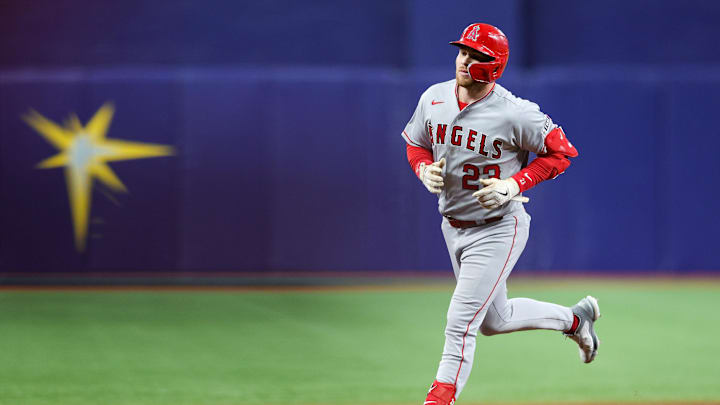Internal
The best internal option for second base right now would be Jared Triolo. For years, Triolo was one of the most unheralded prospects in the Pirates’ system. His lowest single-season wRC+ throughout his minor league career was 110, meaning at his worst, he was still 10% better than average. Triolo’s first promotion to the bigs was not great. His first 137 plate appearances yielded a .273/.350/.314 triple-slash, .303 wOBA, and 87 wRC+. While he hit for a good average, and walked at an 8.8% rate, he also did not hit for much power and struck out 30.7% of the time.
Triolo was sent back to Triple-A to figure things out, and when he came back, he looked like a greatly improved player. The 72 plate appearance sample in September saw him bat .350/.457/.567 with a .440 wOBA, and 178 wRC+. He walked nearly twice as often with a 16.7% walk rate, but still struck out about 30% of the time (29.2%). However, what makes this sample size worrying is the stratospheric .514 batting average on balls in play, which is unsustainable in any sense of the word.
However, even when his BAbip falls below .500, there were many positives to be taken from his September sample size. Triolo was barreling up the ball much more frequently with a 90.4 MPH exit velo, 12.8% barrel rate, and 38.5% hard-hit rate. This is significantly better than the 84.8 MPH exit velo, 2.5% barrel rate, and 30% hard-hit rate Triolo owned in his first promotion.
Triolo has always been known for his athleticism and defensive capabilities. His primary position throughout the minor leagues was third base, but he was more than talented enough to move to another position. Triolo played second base for 87 innings, but racked up +1 defensive runs saved, and +2 outs above average.
Another player currently on the 40-man roster who could have a shot at second base is Liover Peguero. Peguero started off his MLB career hot, batting .274/.323/.462 through his first 129 plate appearances. Although he had a mediocre 6.2% walk rate and 27.9% strikeout rate, he hit for good pop with a .188 ISO and six home runs. His 88 MPH exit velocity, 7.1% barrel rate, and 35.7% hard hit rate were slightly below average, but still manageable.
Peguero may have secured his grasp on the second base role, had it not been for a poor final home stretch. In his last 84 plate appearances, Peguero batted .185/.214/.247 with a wRC+ of just 20. Keep in mind Austin Hedges finished the 2023 regular season with a 24 wRC+. Peguero struck out at a 36.9% rate and only walked in 3.6% of his plate appearances. The power he once showed in his first showing had disappeared as he only had an ISO of .062 with just one home run.
Peguero split his time between shortstop and second base. His defense at second base received mixed reviews. While he had -4 DRS, he also was considered average in the eyes of OAA at zero. However, he was worse at shortstop with -3 DRS and -1 OAA.
A third option is Nick Gonzales. Gonzales saw much less playing time than Peguero did in the majors, only appearing at the plate 128 times. He struggled, only hitting .209/.268/.348 with a .268 wOBA, and 64 wRC+. He had a 4.7% walk rate and 28.1% strikeout rate. However, Gonzo did well at Triple-A, batting .281/.379/.507 with a .388 wOBA, and 121 wRC+. Gonzales also had a good second half at Triple-A with a 141 wRC+, cutting his strikeout rate to 23.8%.
Gonzales’ second base defense looked fine as he had -1 DRS and +1 OAA in 230.2 innings. He’s never been lauded as an outstanding defensive 2B, but can hold his own at the position. He’s always projected as an average, maybe slightly above average defender at the position. He also logged 59 innings at short with +1 DRS and 0 OAA.
The fourth and final potential internal option for second base is Ji Hwan Bae. Bae was not a great hitter, slashing just .231/.291/.311 with a .272 wOBA, and 66 wRC+. Bae had an 8.1% walk rate, but also struck out 24.8% of the time. He hit just two home runs with an ISO under .100, but he did swipe 24 bases and was worth +2.9 base running runs. But it’s not like Bae was always a horrible hitter throughout the year. On June 9th, he was hitting .277/.335/.361. Sure, he had no power, but a .277 AVG and .335 OBP with his speed his a real threat.
Bae’s second base defense was not received well. He had -6 DRS and -2 OAA. But Bae looked decent out in center field this past season. He had -1 DRS, but +3 OAA. His throws from the outfield were also fairly strong, as he was in the 69th percentile of throwing velocity among position players at 87.5 MPH. Among center fielders, he was above average, coming in at 35 out of 65 qualified center fielders.
